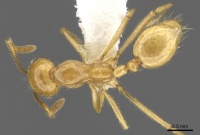Megalomyrmex caete
| Megalomyrmex caete | |
|---|---|

| |
| Scientific classification | |
| Kingdom: | Animalia |
| Phylum: | Arthropoda |
| Class: | Insecta |
| Order: | Hymenoptera |
| Family: | Formicidae |
| Subfamily: | Myrmicinae |
| Tribe: | Solenopsidini |
| Genus: | Megalomyrmex |
| Species: | M. caete |
| Binomial name | |
| Megalomyrmex caete Brandão, 1990 | |
The type series was collected by W.L. Brown Jr. from “mt. base. Forest”.
Identification
Distribution
Latitudinal Distribution Pattern
Latitudinal Range: -2.166666667° to -2.691°.
| North Temperate |
North Subtropical |
Tropical | South Subtropical |
South Temperate |
- Source: AntMaps
Distribution based on Regional Taxon Lists
Neotropical Region: Ecuador (type locality).
Distribution based on AntMaps
Distribution based on AntWeb specimens
Check data from AntWeb
Countries Occupied
| Number of countries occupied by this species based on AntWiki Regional Taxon Lists. In general, fewer countries occupied indicates a narrower range, while more countries indicates a more widespread species. |

|
Estimated Abundance
| Relative abundance based on number of AntMaps records per species (this species within the purple bar). Fewer records (to the left) indicates a less abundant/encountered species while more records (to the right) indicates more abundant/encountered species. |

|
Biology
Castes
Nomenclature
The following information is derived from Barry Bolton's Online Catalogue of the Ants of the World.
- caete. Megalomyrmex caete Brandão, 1990b: 422, figs. 2, 9, 27 (w.q.) ECUADOR.
- Type-material: holotype worker, 4 paratype workers, 1 paratype queen.
- Type-locality: holotype Ecuador: Prov. Guayas, 3 km. SW Bucay, 24.vii.1973 (W.L. Brown); paratypes with same data.
- Type-depositories: MCZC (holotype); BMNH, MCZC, MZSP (paratypes).
- Status as species: Brandão, 1991: 354; Bolton, 1995b: 249.
- Distribution: Ecuador.
Unless otherwise noted the text for the remainder of this section is reported from the publication that includes the original description.
Description
Worker
Mandibles smooth; anterior border of clypeus with median denticle; flat median area of clypeus limited by carinae (better seen at 80x); 3-segmented antenna! club; 10-12 ocular facets at eye largest diameter; occipital margin not raised; dorsal profile of promesonotum continuous, promesonotum suture impressed laterally; meso sternum and metasternum without acrotergites; dorsal face and declivity of propodeum meeting in a gentle angle; declivity with 3-4 concentric rugosities over the foramen; petiole with an teroventral denticle; petiolar node, in frontal view, acuminate; postpetiole ventral process globose.
Pilosity: 6 long erect hairs (more than .2mm) at pronotum, 4-6 at the apex of petiole and post petiole, 15-16 at the gaster segments and anterior face of fore coxae. Small subdecumbent hairs (circa .lmm) uniformly distributed over the body surface. Color: uniform bright light-yellow.
Queen
Clypeal carinae only at the posterior region of clypeus; ocelli equally developed; parapsidal sutures impressed on mesonotum; scutum and scutellum with 2 parallel rows of long hairs; ventral process of postpetiole acuminate.
Type Material
3 Km SW Bucay, prov. Guayas, Ecuador (02°10'S, 79° 06'W). Holotype (worker) and 2 paratypes (workers) at Museum of Comparative Zoology, Harvard Univ.; 1 paratype (worker) at British Museum of Natural History; 2 paratypes (queen and workers) at Museu de Zoologia da USP.
Etymology
Caete means forest in Tupi.
References
- Brandão, C. R. F. 1990b. Systematic revision of the Neotropical ant genus Megalomyrmex Forel (Hymenoptera: Formicidae: Myrmicinae), with the description of thirteen new species. Arq. Zool. (São Paulo) 31: 411-481 (page 422, figs. 2, 9, 27 worker, queen described)
References based on Global Ant Biodiversity Informatics
- Ulyssea M. A., C. R. F. Brandao. 2013. Catalogue of Dacetini and Solenopsidini ant type specimens (Hymenoptera, Formicidae, Myrmicinae) deposited in the Museu de Zoologia da Universidade de Sao Paulo, Brazil. Papies Avulsos de Zoologia 53(14): 187-209.

